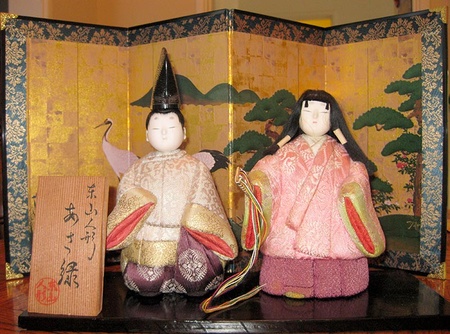At Centenary Church’s annual bazaar1, I stopped at a table full of discards, and asked the saleslady how much for “THAT?”…a pair of old paper dolls inside a flimsy cardboard box. She dawdled; her eyes swept me from top to bottom, and she left to confer with her associates. While their chat was inaudible, their raised eyebrows, nods, and shoulder-shrugging were raucous. The woman came back, and trying to hide a smirk, she hinted: “A…dollar?” Quickly, I handed her the money, praying for no sudden change of her mind. “Thanks, Jiichan,” she said, which really meant: “Ah, the ravages of age!”
“THAT” was a tachibina, a pair of standing Prince and Princess dolls. No taller than seven centimeters, the princess modeled a beautiful red kimono, while the prince, about ten centimeters tall, sported a gold and purple hakama; they stood close together on a small wooden base. I marveled at the meticulously detailed creation: the right number of collars under the top garments; the size and placement of the obi; the minute purple and red accents on the kimono sleeves; and even the break of the hakama at knee’s length. In the bottom of the box was a red silk lining. Just out of curiosity I lifted the piece, turned it, and found it to be a little bag decorated with two stunning dairibina, a sitting prince and his princess. What a caché of superb washi ningyo for a paltry dollar…Not bad for an old jii-chan!
In Japan, the paradise of toys, children never lacked objects to love and caress. But, for more than ten-thousand years, ningyo, have earned a hallowed place in the Japanese home as lair protectors, fertility boosters, and offspring guardians. They’ve served loftier functions than mere “play.” Hinamatsuri, the Girls’ Festival (better yet Dolls’ Festival) is a good example. Despite its inherent playfulness, and to the dismay of feminists, the event seems also a lesson about the rigors of a demanding social code, in which males are dominant and women compliant. (“Put the display away by March 3 or you’ll marry late.”) Westernization, and more recently anime have somewhat dinged the key ningyo traditions; yet, even the most atrocious manga life-forms seem endowed with powers as awesome as those of our old fetishes.
In creating even the simplest dolls, I attempt to blend the mundane and the otherworldly elements of ningyo . All one needs is basic origami folds, colorful washi, and a trace of imagination. Easiest to craft are dairibina, sitting Prince and Princess, symbolizing love, and requiring only yuzen for the top wear, and perhaps unryu for the undergarments. Similarly, the icon for devotion, anesama—elder sister—barely demands time and stock. A notch more difficult is tachibina, a standing couple conveying marital fidelity. For best effect, I dress the Princess with a portion of the washi chosen for the Prince’s outfit. If the pair refuses to stand solidly on a base, just paste it on a shikishi, or a greeting card.
Twenty-one years ago, in Little Tokyo, I found Shigeo Suwa’s book “Japanese Paper Dolls.” It shows step by step, how to make beautiful creatures with shimotsuke, a crepe or gathered paper which behaves as soft fabric, and was originally brought from China to Northern Kanto.
Shimotsuke dolls call for time and serenity. Sculpting the body with cotton and wire, particularly the head, is a rather trying chore because the doll must be able to stand perfectly balanced. Shimotsuke is sometimes difficult to find; then, I create my own momigami. On a smoothly waxed 1” dowel, I loosely drape the horizontal side of a damp piece of sturdy yuzen. Carefully, I squeeze it downwards to insure crinkling the paper thoroughly. Next, I repeat the process with the vertical side of the paper; when dry I use it for the doll’s wear. With shimotsuke, one can create just a lovely small child, or fashion the splendid champion of an ancestral folktale, in full gear.
Lots of work, indeed! But when I finish a well-crafted project, submit it for competition, and it wins a ribbon or two, I feel that the enthralling soul of ningyo has rested comfortably on my hands. (Ningyo will visit again, in future columns.)
Notes:
1. Centenary Church in Little Tokyo, Los Angeles holds yearly its Arigatoo Bazaar in May.
*This article was first appeared in the East San Gabriel Valley’s Japanese Community Center’s “Newsette” in March 2007.
© 2007 Edward Moreno







